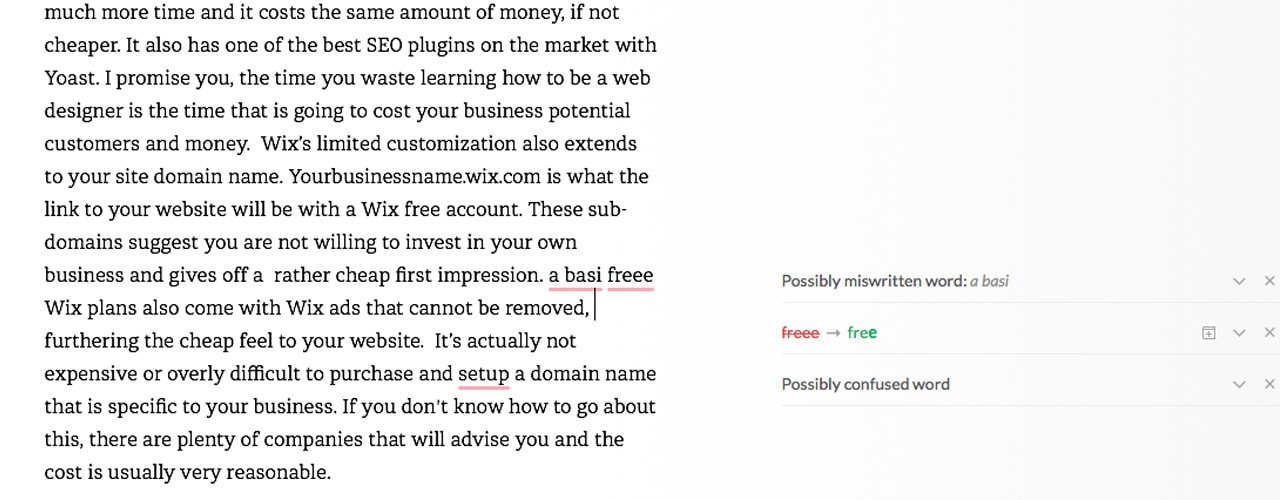How to Start a Blog for Your Business
Are you struggling to start a blog for your business? If the answer is yes, you’re not alone. Many small business owners know the benefits of blogging but don’t know where to begin. As a result, they procrastinate and avoid the task altogether.
For this reason, it is important to take baby steps and be patient with yourself while you learn. Keep it real and understand it’s not always easy to add a new skill to your repertoire. If you follow the steps below, you’ll successfully ease into the world of blogging.
1. Become Aware and Document Your Ideas
If you’re reading this post, you’re probably an expert in your field. It’s important to realize that your customers pay you because you’re the expert. Even if you’re not the world’s top expert in your field, you still know more about your job than your customers do.
You may not realize it at first, but you have plenty of insight to offer. Topics you might consider to be mundane are actually interesting to your customers.
To illustrate, let’s pretend you’re a computer technician. You use quick commands, or keyboard shortcuts, every day. You use them so much that you don’t even think about them anymore.
Guess what? Your customers probably don’t know these commands, let alone use them.
Try writing a blog post that lists the 5 most commonly used Mac commands, or PC shortcuts. Ultimately, you educate your customers and add valuable content to your website. It’s a win-win.
Basically, by staying mindful throughout the day, you naturally think of great ideas and helpful information worthy of sharing with your audience. It’s amazing how many ideas for blog posts you generate throughout the day once you become aware. For this reason, it’s important to document your ideas when they come up so you remember them later when you have time to write.
*Helpful Tools: Try keeping a small notebook with you so when genius strikes, you have a place to store those ideas. If you’re a digital person, use your phone for note taking. Use whatever works best for you. If you document of all that noise in your head, you might surprise yourself.

2. Planning and Scheduling
In order to avoid procrastination, it’s important to set a schedule for publishing your posts ahead of time. Now that your mindfulness has produced a list of blog topics, you’re ready to organize them into categories and set a publishing schedule. First, take your list of blog post ideas and begin sorting them into categories.
To illustrate, we’ll use the same computer technician. His quick command or shortcut post could be placed into a category called “productivity.” This category would contain all of his posts containing tips for his customers to become more productive.
It’s important to remember that there are no rules here. You’re simply organizing post ideas so readers can find them easily in the future. If you’d like to dig deeper into categories and blog structure, read this brilliant post by Yoast.
Once you have the main categories, you can create a schedule for your posts. At first, aim for one blog post per month and grow from there. Yes, eventually you want to produce content more frequently but it takes time and practice to get there. Posting quality content once a month is far better than posting nothing at all.
*Helpful Tools: If you are having trouble with categories try Google Trends to help discover popular, or trending topics. This helps you create engaging content that has a good chance of driving traffic to your website. I will address SEO and keyword research in future posts. For now, we want to keep it simple.
3. Writing
After you’ve completed the first two steps, you’re ready to start writing! Most new bloggers dread this part the most. It’s important to realize that starting to write is the most difficult part of writing a blog.
Create an Outline
Create an outline and take it from there. Write or type out the key bullet points. Don’t worry about spelling or grammar. Just list the key points you want to convey to the reader. Our example computer technician’s outline would look similar to this:
Topic: Useful Shortcuts and Quick Commands.
- Cut – Command/Control X
- Copy – Command/Control C
- Paste – Command/Control V
- Cycle Apps – Command/Control Tab
- Cycle Windows – Command/Control ~
Add Details
After you complete the outline, start filling in the details. Before you know it, you’ve finished the bulk of your blog post. Next, add intro and conclusion paragraphs. Example below:
Title: Useful Shortcuts and Quick Commands for Mac and PC Users
Category: Productivity
Intro: This post is important because it provides information that will help you become more productive on your computer. Here is a list of five shortcuts that improve productivity:
Subheadings:
- Cut – Command/Control X (followed by details)
- Copy – Command/Control C (followed by details)
- Paste – Command/Control V (followed by details)
- Cycle Apps – Command/Control Tab (followed by details)
- Cycle Windows – Command/Control ~ (followed by details)
Conclusion / Call to Action:
Thanks for reading. You’re well on your way to becoming more productive. Feel free to give me a call if you get stuck!
4. Proofreading / Editing:
After you finish writing your blog post, let it sit for a few hours or even overnight. You want to proofread it with fresh eyes. When you’re ready, check your document for grammar and spelling errors. Make sure your post is easy to read. Once you’re satisfied, the post is ready to publish!
*Helpful Tools: I like using good old Microsoft Word for drafts and outlines. It’s simple and easy to use. I use Grammarly for proofreading and grammar. Grammarly offers free and paid versions. The free version works great for beginners.
5. Publishing
I suggest using WordPress to publish company blogs. It’s easy, SEO-friendly and highly customizable. Ultimately, the goal is to drive traffic to your website and improve your search engine rankings by providing useful information to potential customers.
If you’re just starting out and your website is not using WordPress yet, there are numerous free self-publishing platforms available. Medium gives business owners a great opportunity to share and promote their brand with other bloggers. Their website offers a wide variety of topics and publications.

6. Promotion
Once your blog is published, share the link on your social media platforms. Facebook, LinkedIn, and Twitter are great places to share your posts. Join some LinkedIn groups and share your post with other business owners. Don’t be shy or hesitant. Instead, be proud of yourself and finished work!
*Helpful Tools: Most social media platforms have created separate groups and forums where online communities gather to discuss industry-specific topics. Facebook Groups are a great place to start. They have a wide range of groups across multiple categories. If you haven’t looked into it yet, join a few groups today.

Still Not Sure How to Start a Blog?
At first, blogging might seem like an overwhelming task but it does get easier after you stop procrastinating.
Take your time and enjoy the learning experience. Knowing how to start a blog provides a great opportunity to engage with others and spread your knowledge with the online community.
Ultimately, you should produce quality content on a regular basis… but we are being realistic here. If you loathe writing and avoid it at all costs, look for ways to make it enjoyable. If you need guidance, feel free to contact me!

Jean Templeton is a public relations director and copywriter who works with small business owners and aspiring entrepreneurs to help grow their personal brands and businesses.
Jean is the co-founder of Consonant Marketing and believes in creating content that is organically produced and custom made. She is professionally trained in Search Engine Optimization (SEO) and specializes in Creative Writing and Public Relations.








